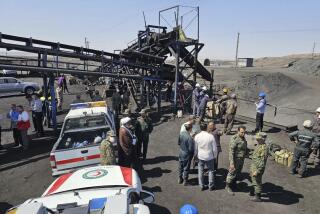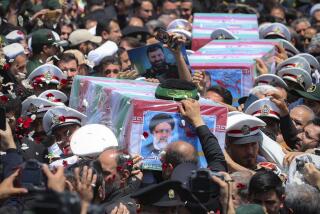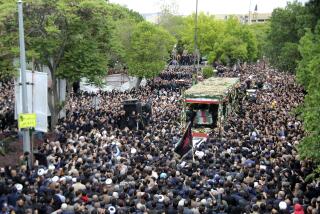Death Toll in Iran Quake Nears 29,000 : Disaster: Rescue workers struggled to reach survivors as aftershocks continued to rock the area. About 100,000 people are believed injured and 400,000 are homeless.
TEHRAN — Rescue workers and dazed survivors struggled Friday to dig thousands of dead and injured from the rubble of an earthquake in northwest Iran as the official death toll rose to nearly 29,000--the highest for an earthquake in 14 years.
A dozen towns and hundreds of villages were devastated by the temblor that spread across two provinces near the Caspian Sea early Thursday. Aftershocks continued to rock the area, with 140 counted by Friday.
The Red Cross in Geneva, quoting the Iranian Red Crescent Society, said about 400,000 people are believed homeless. The Iranian mission to the United Nations estimated that 100,000 were injured.
“Whole towns were flattened like they were never there. We have no way to get to many,” said Mohammad Afshar, a Red Crescent official.
“For the next 10 days we will be digging through the rubble for corpses,” Afshar said. “Roads are blocked by falling rocks, and planes have difficulty landing in the mountains of Gilan,” a province on the Caspian Sea coast hit by the quake.
Iran’s official news agency IRNA reported Friday that the known dead number 28,950. It said 25,241 bodies have been counted in Gilan province, on the Caspian Sea, and 3,709 in Zanjan province. That toll surpasses the 25,000 killed in Soviet Armenia in December, 1988, and is the highest know worldwide since July, 1976, when a earthquake in China reportedly killed 242,000.
The U.N. Disaster Relief Organization in Geneva said it was told by the Iranian Foreign Ministry that the death toll was expected to reach 35,000, with 105,000 people injured. A total of 28,198 people were injured in the two provinces, IRNA said.
More shocks followed the big quake. Interior Minister Abdullah Nouri said a main road in the disaster zone, cleared Thursday, was blocked by a fresh landslide Friday.
President Hashemi Rafsanjani visited the hardest-hit area, including the town of Roudbar in the Caspian province of Gilan, where at least 6,000 died.
He told reporters that Iran, fiercely proud of its self-reliance since Ayatollah Ruhollah Khomeini’s 1979 Islamic Revolution, would accept foreign help for quake victims.
Rafsanjani said “nothing worth mentioning” was left of towns and villages he saw during a helicopter flight over the quake zone. Gilan province and adjoining Zanjan have a population of about 4 million people.
Four of Iran’s bitter enemies--the United States, Israel, Iraq and Saudi Arabia--sent offers to help. A senior U.S. official in Washington said the American offer was accepted.
“The catastrophe is so serious . . . “ Rafsanjani told IRNA. “International help is needed. We should accept the help that is offered.”
He said the greatest need is for heavy equipment--especially cranes to lift huge pieces of rubble.
Iran told the Swiss-based League of Red Cross and Red Crescent Societies that it needed medicine, tents, blankets, food, trucks, cranes and bulldozers. It said it did not need doctors and other experts or blood supplies, sniffer dogs or used clothing.
Iranian television showed doctors tending victims on stretchers in a makeshift hospital in a parking lot. Masked rescuers in white aprons pulled dust-covered bodies from under concrete slabs. Corpses were laid on blocks of ice in open trucks.
Television showed scenes of devastation, including the remains of an entire row of hillside village houses that collapsed and slid down the hill.
Rescuers scooped up rubble and used police dogs to find victims. They gently fed water to one man who was trapped in a mass of stones and earth, only his head protruding.
At Manjil in Gilan province, Parvin Nemati clutched the headless body of one daughter wrapped in a blanket. Her husband and relief workers unearthed the body of another daughter, 10-year-old Fatemeh, an Iranian correspondent reported.
A man in Roudbar told Iranian television “a rock as big as a building” crashed into his home, killing four of his six children. His wife said she lay in the ruins for hours with one of the surviving children beside her.
“There is not a single house in this area which has been left standing,” farmer Ali Mohammadi said in Roudbar.
Television showed villagers looking at houses turned into heaps of mud bricks and wooden beams by the quake, which was measured at a magnitude of 7.3 by Tehran University; the U.S. Geological Survey in Golden, Colo., put it at 7.7.
Farhad Shad, a spokesman for the Geophysics Center at Tehran University, told IRNA that 140 aftershocks were registered after the killer earthquake.
Hospitals overflowed with victims. Tehran Radio said some of the injured were flown 600 miles from the disaster zone for treatment.
Tehran airport was thronged with people trying to reach the quake zone to learn the fate of relatives. Officials turned them back, saying the planes were needed for relief workers.
A French government plane carrying 205 rescue workers, 18 sniffer dogs and 25 tons of aid was heading for Iran, although the Iranian Red Crescent said experts were not needed.
A 17-member British team set out with ultrasonic listening devices and thermal cameras which can sense body heat beneath ruins. A planeload of doctors, rescue workers and aid was on its way from the Soviet Union.
Five members of the Paris-based charity Doctors Without Frontiers were already helping at an air force hospital in Tehran, IRNA said.
More to Read
Sign up for Essential California
The most important California stories and recommendations in your inbox every morning.
You may occasionally receive promotional content from the Los Angeles Times.










